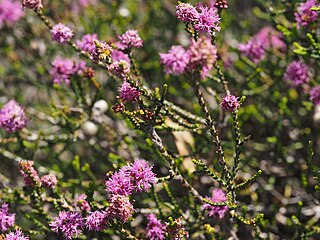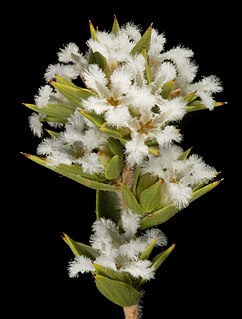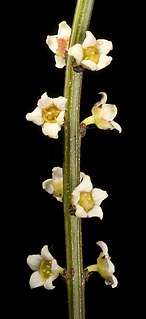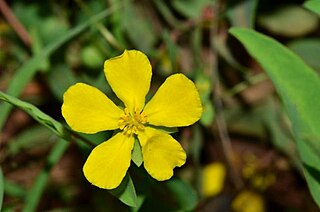
Melaleuca cliffortioides is a plant in the myrtle family, Myrtaceae and is endemic to the south-west of Western Australia. It is a small, prickly shrub very similar to Melaleuca podiocarpa but with fewer stamens in the flowers.

Melaleuca depressa is a plant in the myrtle family, Myrtaceae and is endemic to the south-west of Western Australia. It is a small, bushy shrub with clusters of yellow or cream flowers on the ends of its branches in spring.

Melaleuca psammophila is a plant in the myrtle family, Myrtaceae, and is endemic to the south-west of Western Australia. It is a small shrub with narrow leaves, heads of purple, pink or mauve flowers and clusters of woody fruit. It is similar to M. bisulcata but differs from that species in characters such as the shape of its fruit, leaves and buds but like that species is an attractive, profusely flowering shrub suitable for cultivation as a garden plant.

Regelia cymbifolia is a plant in the myrtle family, Myrtaceae and is endemic to the south-west of Western Australia. It is a much branched shrub bearing tiny, wedge shaped leaves and clusters of deep pink to purple flowers on the ends of its branches in spring.

Acacia aestivalis is a shrub belonging to the genus Acacia and the subgenus Phyllodineae that is native to Western Australia.

Grevillea uncinulata, also known as hook-leaf grevillea, is a shrub of the genus Grevillea native to an area in the Wheatbelt, southern Mid West, northern Great Southern and western Goldfields-Esperance regions of Western Australia.

Kunzea montana, commonly known as mountain kunzea, is a flowering plant in the myrtle family, Myrtaceae and is endemic to the south-west of Western Australia. It is a shrub or small tree with more or less round leaves and heads of cream-coloured to pale yellow flowers on the ends of the branches in late spring. It is an uncommon species, growing on rocky mountain slopes, but all populations are conserved in the Stirling Range National Park.
Baeckea grandibracteata is a shrub found in central Western Australia.
Baeckea grandis is a shrub found in central Western Australia.
Conothamnus neglectus is a member of the family Myrtaceae endemic to Western Australia. This open shrub typically grows to a height of 0.2 to 1.0 metre. It blooms in between July and September producing yellow flowers.
Conospermum eatoniae, commonly known as blue lace, is a shrub endemic to Western Australia.
Hakea recurva subsp. arida is a plant in the family Proteaceae endemic to the south-west of Western Australia.
Hibbertia andrewsiana is a species of flowering plant in the family Dilleniaceae and is endemic to the south-west of Western Australia. It is a shrub with an erect or spreading habit and typically grows to a height of 15–60 cm (5.9–23.6 in). It blooms between September and January and produces yellow flowers.

Leucopogon oliganthus is a shrub in the family Ericaceae found in Western Australia.

Philotheca tomentella is a species of flowering plant in the family Rutaceae and is endemic to the south-west of Western Australia. It is an undershrub with small club-shaped to cylindrical leaves and white flowers with a pale red central stripe, arranged singly or in groups of up to four on the ends of branchlets.

Blennospora phlegmatocarpa is a herb species in the family Asteraceae. It is found in Western Australia.

Androcalva luteiflora is a shrub in the family Malvaceae. It is native to Western Australia and the Northern Territory.
Goodenia eremophila is a species of flowering plant in the family Goodeniaceae and is endemic to inland areas of Western Australia. It is an ascending herb with linear to elliptic leaves and thyrses of blue flowers.

Psammomoya is a genus of plants in the Celastraceae family, endemic to Western Australia. The genus was first described by Ludwig Diels and Ludwig Eduard Theodor Loesener in 1904, with the designated type species being Psammomoya choretroides.

Hibbertia silvestris is a species of flowering plant in the family Dilleniaceae and is endemic to the south-west of Western Australia. It is a prostrate to more or less erect or spreading shrub with hairy young branchlets, elliptic to egg-shaped leaves with the narrower end towards the base and yellow flowers with seven to ten stamens on one side of two softly-hairy carpels.












